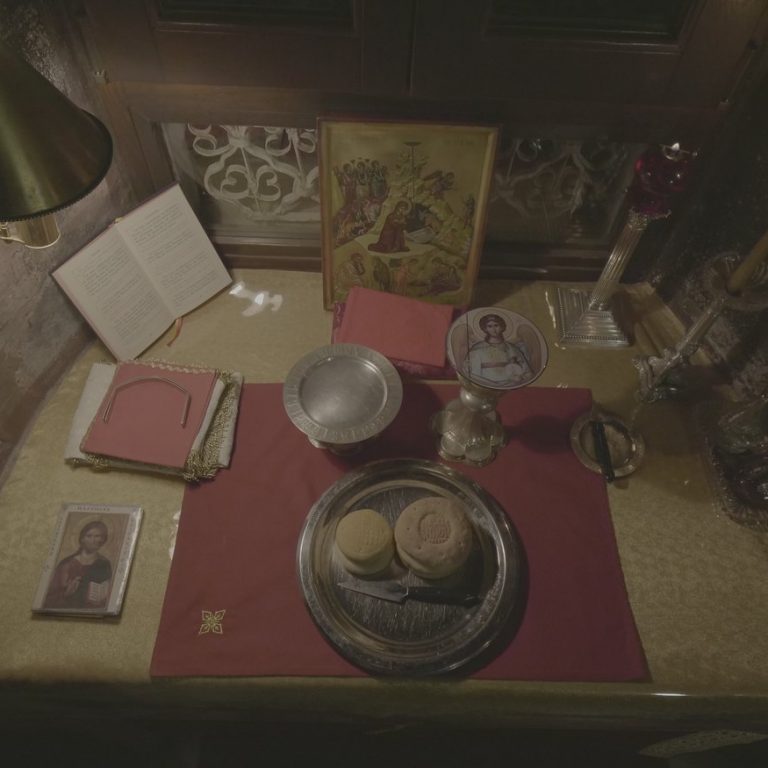The Sanctuary
In 1614, significant renovation work were undertaken in the area of the Sanctuary, which was extended about five meters to the east, while at two of its corners, the northeastern and the southeastern, two polygon-shaped, dome-covered rooms (typicaria) were constructed.
The nave is separated from the area of the Sanctuary by the exceptionally crafted carved and gold-plated wooden τέμπλο (templo, or 'icon screen'), the third in the history of the cathedral, which was made in 1614 by Chrysanthos Cliedi, and is decorated with floral themes. The functional role of the icon screen is provided by an exceptionally important document, not only because it contains chronological details and information about the craftsmen who constructed it, but also because, according to the archaeologist I. Papangelo, it is the first documented use of the term templo to denote the use of this type of architectural element to physically separate the sanctuary from the rest of the nave.
The primary decoration of the screen consists of two magnificant icons: Χριστού Παντοκράτορος (Pantokratoros, 'Christ the Ruler of All') and the Θεοτόκου της «Πάντων Χαράς ('The Blessed Mother, the Joy of All)', works of Theofanos of Crete (1535-1546). The icon of Τιμίου Προδρόμου ('St John the Baptist'), with its scenes from his life and martyrdom, was donated in 1655 by the monk Adonios of Chilandarino. Another significant icon is that of the Archangels, at the right of the Pantokratoros icon, which dates to the 17th century and is the oldest surviving portable icon. Scenes depicting miracles performed by the archangels are presented around the perimeter of the icon, with particular attention paid to the four scenes depicting the miracle at the Docheiarios Monastery.
Icons of the twelve apostles decorate the second zone of the screen, while the top section is dominated by the remarkably large-sized Εσταυρωμένος (Estavromenos, 'The crucified One'), a work of a Cretan workshop from the end of the 16th century. Related icons from this workshop, Τα Λυπηρά ('The Mourners', the left and right side panels of the Estavromenos, depicting the mourning Blessed Mother and St John the Theologian) are presently safeguarded in the Sacristy of the Monastery.
The gold-plated, carved wooden doors of the screen are the work of the monk Isaia, and are decorated with 31 small images of prophets and apostles, as well as with the scenes from the Crucifixion and the Annunciation. They date to 1622, according to the relevant records.
Inside the Sanctuary, the wood-carved, pillar-supported κιβώριο (ciborium, 'canopy') above the marble altar dominates the space. On its interior surface, scenes from the 'Heavenly Liturgy' are depicted.
The nave is separated from the area of the Sanctuary by the exceptionally crafted carved and gold-plated wooden τέμπλο (templo, or 'icon screen'), the third in the history of the cathedral, which was made in 1614 by Chrysanthos Cliedi, and is decorated with floral themes. The functional role of the icon screen is provided by an exceptionally important document, not only because it contains chronological details and information about the craftsmen who constructed it, but also because, according to the archaeologist I. Papangelo, it is the first documented use of the term templo to denote the use of this type of architectural element to physically separate the sanctuary from the rest of the nave.
The primary decoration of the screen consists of two magnificant icons: Χριστού Παντοκράτορος (Pantokratoros, 'Christ the Ruler of All') and the Θεοτόκου της «Πάντων Χαράς ('The Blessed Mother, the Joy of All)', works of Theofanos of Crete (1535-1546). The icon of Τιμίου Προδρόμου ('St John the Baptist'), with its scenes from his life and martyrdom, was donated in 1655 by the monk Adonios of Chilandarino. Another significant icon is that of the Archangels, at the right of the Pantokratoros icon, which dates to the 17th century and is the oldest surviving portable icon. Scenes depicting miracles performed by the archangels are presented around the perimeter of the icon, with particular attention paid to the four scenes depicting the miracle at the Docheiarios Monastery.
Icons of the twelve apostles decorate the second zone of the screen, while the top section is dominated by the remarkably large-sized Εσταυρωμένος (Estavromenos, 'The crucified One'), a work of a Cretan workshop from the end of the 16th century. Related icons from this workshop, Τα Λυπηρά ('The Mourners', the left and right side panels of the Estavromenos, depicting the mourning Blessed Mother and St John the Theologian) are presently safeguarded in the Sacristy of the Monastery.
The gold-plated, carved wooden doors of the screen are the work of the monk Isaia, and are decorated with 31 small images of prophets and apostles, as well as with the scenes from the Crucifixion and the Annunciation. They date to 1622, according to the relevant records.
Inside the Sanctuary, the wood-carved, pillar-supported κιβώριο (ciborium, 'canopy') above the marble altar dominates the space. On its interior surface, scenes from the 'Heavenly Liturgy' are depicted.

